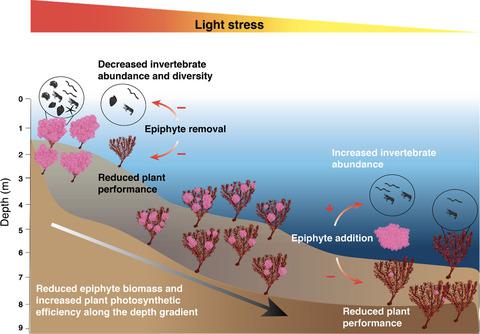Our official English website, www.x-mol.net, welcomes your
feedback! (Note: you will need to create a separate account there.)
Positive cascading effects of epiphytes enhance the persistence of a habitat‐forming macroalga and the biodiversity of the associated invertebrate community under increasing stress
Journal of Ecology ( IF 5.3 ) Pub Date : 2020-10-29 , DOI: 10.1111/1365-2745.13539 Chiara Ravaglioli 1, 2 , Joachim Langeneck 1 , Antonella Capocchi 1 , Alberto Castelli 1 , Debora Fontanini 1 , Paul E. Gribben 3, 4 , Fabio Bulleri 1, 2
中文翻译:

附生植物的正级联效应在不断增加的压力下增强了形成栖息地的大型藻类和相关无脊椎动物群落生物多样性的持久性
更新日期:2020-10-29
Journal of Ecology ( IF 5.3 ) Pub Date : 2020-10-29 , DOI: 10.1111/1365-2745.13539 Chiara Ravaglioli 1, 2 , Joachim Langeneck 1 , Antonella Capocchi 1 , Alberto Castelli 1 , Debora Fontanini 1 , Paul E. Gribben 3, 4 , Fabio Bulleri 1, 2
Affiliation

|
- Enhanced persistence of stress sensitive species in harsh environments due to amelioration of physical stress by habitat‐forming species has been widely documented. By contrast, less attention has been given to positive species interactions that may enhance stress tolerance in habitat‐forming species, with positive cascading effects on biodiversity and ecosystem functioning.
- We used a combination of field surveys and experiments to assess the effects of the epiphyte Jania rubens, on its subtidal macroalgal host Halopithys incurva, and their cascading effects on the associated invertebrate community, along a depth gradient associated with increasing stress (i.e. light stress at shallower depths).
- Correlative studies showed that the biomass and photosynthetic efficiency of H. incurva increased with depth, along with a decrease of epiphyte biomass. The experimental manipulation of epiphytes (removal in shallow water and addition in deep water) revealed that their effects on H. incurva physiology varied from positive in shallow habitats to negative in deep habitats. These results suggest that reduction of light/UV stress by J. rubens allows H. incurva to persist in shallow‐water habitats that would be otherwise unsuitable. In addition, colonization by large clumps of J. rubens increased the abundance and diversity of associated invertebrates in shallow habitat, suggesting that positive feedbacks between H. incurva, acting as the primary habitat‐former, and J. rubens, acting as a secondary habitat‐former, generate a facilitation cascade.
- Synthesis. Our study suggests that the persistence of some habitat‐forming species and their ability to support biodiversity may rely upon physical stress reduction by other species (e.g. epiphytes in our case) that are generally neglected when planning conservation strategies. A deeper understanding of context dependency in positive species interactions is essential for predicting patterns of species distribution under increasingly stressful climate scenarios.
中文翻译:

附生植物的正级联效应在不断增加的压力下增强了形成栖息地的大型藻类和相关无脊椎动物群落生物多样性的持久性
- 已有广泛文献记载,由于栖息地形成物种减轻了身体的压力,其在恶劣环境中增强了胁迫敏感性物种的持久性。相比之下,人们对积极的物种相互作用的关注较少,这些相互作用可能会增强栖息地形成物种的压力承受能力,并对生物多样性和生态系统功能产生积极的连锁影响。
- 我们结合野外调查和实验,评估了附生植物Jania rubens对潮下大型藻类寄主Halopithys incurva的影响,以及它们对与相关无脊椎动物群落的级联效应,以及与压力增加有关的深度梯度(即在较浅的深度)。
- 相关性研究表明,弯弯曲菌的生物量和光合效率随着深度的增加而增加,而附生生物量的减少。对附生植物进行实验性实验(在浅水中去除并在深水中添加)表明,它们对弯曲弯曲杆菌生理的影响从浅生境中的阳性变化到深生境中的阴性变化。这些结果表明通过减少光/ UV应力J.鲁允许H. incurva在浅水栖息地,这将是不适合的,否则坚持。此外,大块的红宝石菌也可以定植增加了浅生境中相关无脊椎动物的丰度和多样性,表明作为主要生境形成者的H. incurva和作为次生栖息地形成者的J. rubens之间的积极反馈产生了促进级联反应。
- 综合。我们的研究表明,某些栖息地形成物种的持久性及其支持生物多样性的能力可能依赖于其他物种(例如本例中的附生植物)的物理压力减轻,而这些物种在制定保护策略时通常被忽略。对正向物种相互作用中的背景依赖有更深入的了解对于预测在日益严峻的气候情景下物种分布的模式至关重要。











































 京公网安备 11010802027423号
京公网安备 11010802027423号